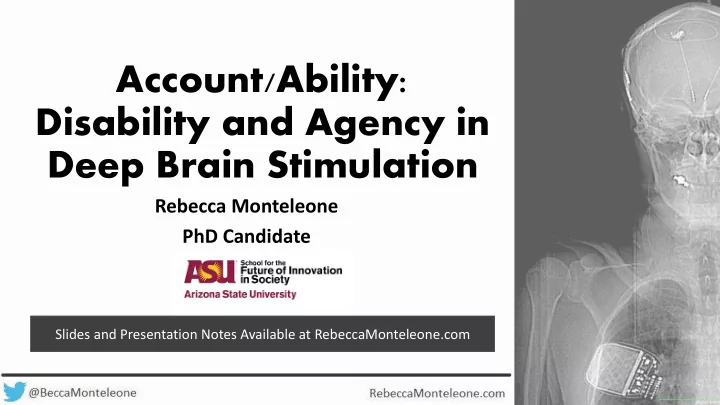

Account/Ability: Disability and Agency in Deep Brain Stimulation Rebecca Monteleone PhD Candidate Slides and Presentation Notes Available at RebeccaMonteleone.com
WHAT IS DBS? • Historical context • Current standard and experimental uses • Characteristics of DBS
THEORETICAL OVERVIEW Neoliberal Ableism Discourse of Bio- Technological medicalization Progress Franklin, 1998; Clarke, et al, 2010; Goodley, 2014
PERSONAL ACCOUNTABILITY
“I needed to lighted the load, which has not been terribly lightened, but I needed to lighten the load of my lovely caregiver wife, who I owe everything to …it’s one of those difficult things, where you know you’re a burden but you don’t know what to do about it …it’s kind of like, you die and go to heaven and you’re all upset at God and you tell him and he’s like, ‘Well, what do you mean? I gave you DBS, why didn’t you try it?...I was just trying to be a better person. ”
“If you don’t do self-management, you’re not going to have a good outcome. ”
EMBODIMENT
“One thing that nobody ever mentioned, not once since I had this is, you know, it actually hurts sometimes … the disease brings pain and, you know, nobody is really talking about that part of it … I don’t know if it’s just by chance or by, you know, the doctors I had, but, you know, there are things that nobody told me I might feel or experience later on. ”
“So, yeah, [DBS] was definitely a feeling of control much more so than any medication that I’d been taking, just because medication has so very specific time frames, you know, especially with narcotics, they only give you a certain amount, so if I’m having a particularly bad pain episode, there is that rationale: ‘Well, I could try to take another pill, but I only have X amount and I’ll have to justify it to a doctor or I may run out. ’”
EPISTEMIC INVALIDATION
“And what really made me mad … i was having side effects and … I should be seeing my neurologist. And not be, you know, sentenced to an area as a guinea pig where they just, in my opinion, dope you up on pills to see if it would help your issues, like mental issues that you’re having, when I knew inside that this was a side effect from the deep brain stimulation. ”
“Because that’s all I wanted to hear from them was why wasn’t anything said that, “Hey by the way … you know what, [Interviewee]? After you had the surgery you might have some side effects, but that’s just the trade off and there’s nothing we can do about it. ” I probably would have been totally cool about it. You know, I would’ve been much more ready for it. So, I didn’t feel like I was alienated and losing my mind. ”
CONCLUSIONS
REFERENCES American Association of Neurological Surgeons. (2019). Deep Brain Stimulation. Retrieved from https://www.aans.org/Patients/Neurosurgical-Conditions-and-Treatments/Deep-Brain- Stimulation. Clarke, A., Mamo, L., Fosket, J., Fishman, J., Shim, J. (eds). (2010). Biomedicalization technoscience, health, and illness in the U.S. Durham, NC: Duke University Press. Endler, N. (1988). The origins of electroconvulsive therapy (ECT). Convulsive Therapy , 4 (1), 5-23. Franklin, (1997). Embodied progress: a cultural account of assisted conception . London ; New York: Routledge. Gagliardi, A. R., Trbovich, P. M., Takata, J., Urbach, D., Lehoux, P., Ducey, A., . . . Bell, C. (2017). Factors constraining patient engagement in implantable medical device discussions and decisions: Interviews with physicians. International Journal for Quality in Health Care , 29(2), 276-282. Gardner, J. (2013). A history of deep brain stimulation: Technological innovation and the role of clinical assessment tools. Social Studies of Science, 43 (5), 707-728. Gilbert, F., Goddard, E., Viana, J., Carter, A. & Horne, M. (2017). I Miss Being Me: Phenomenological Effects of Deep Brain Stimulation. AJOB Neuroscience, 8 (2), 96-109. Goodley, D. (2014). Dis/ability Studies: Theorising Disablism and Ableism (1st ed.) . London: Routledge. Kafer, A. (2013). Feminist, queer, crip . Bloomington, Indiana: Indiana University Press. Mitchell, D. (2014). Gay Pasts and Disability Future(s) Tense. Heteronormative Trauma and Parasitism in Midnight Cowboy. Journal of Literary & Cultural Disability Studies 8 (1), 1 – 16. Photo Credit: https://www.madinamerica.com/2015/09/adverse-effects-perils-deep-brain-stimulation- depression/
Thank You! Rebecca Monteleone PhD Candidate rgmontel@asu.edu Rebeccamonteleone.com
Recommend
More recommend